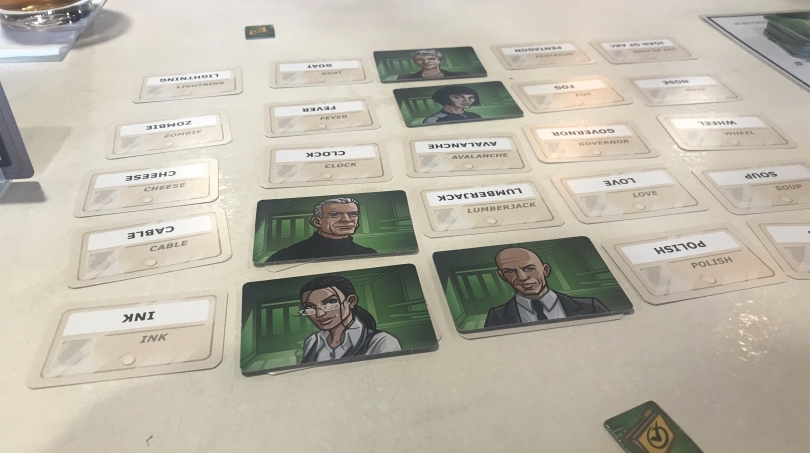 I played Codenames for the first time at PAX Australia in 2015. After a couple of plays, I was in love. It was obvious to me that we had a pretty special party game on our hands, and so I bought it later that day. Unfortunately, by then, the retailers knew it too. They’d hiked the price by $5 by the time I bought my copy, and over the course of the con I saw the price of Codenames jump a few more $5 increments.
I played Codenames for the first time at PAX Australia in 2015. After a couple of plays, I was in love. It was obvious to me that we had a pretty special party game on our hands, and so I bought it later that day. Unfortunately, by then, the retailers knew it too. They’d hiked the price by $5 by the time I bought my copy, and over the course of the con I saw the price of Codenames jump a few more $5 increments.
Two years later, and Codenames has become something of a juggernaut. There are now six versions of the game, including an “adult” version, one which replaces the codename cards with pictures, and versions based on Disney and Marvel properties (which use a combinations of pictures and words). Codenames also has the weird distinction of being one of the few party games that self-labelled “hardcore” gamers don’t turn their nose up at.
The game really is that good.
So, when I say that this recent version of the Codenames franchise is, in my view, the best, I hope you’ll recognise the enormity of that statement.
Duet takes the wildly successful Codenames system and repurposes it for cooperative play in a way that is nothing short of genius. It’s fast, fun, and combines seamlessly with the original Codenames, thereby effectively doubling the word pool of both games. You could even combine the mechanics from Duet with the card pool from Deep Undercover if you were looking for a naughty cooperative experience which, targeted correctly, would probably make a good third date.
So, what did Vlaada Chvatil and Scot Eaton change about classic Codenames to adapt a large group competitive party game into a two player cooperative experience?
Well, rather than two teams racing to guess the words which represent their pool of agents first, Duet challenges you and a partner to identify a shared pool of Agents, while avoiding the dreaded Assassins, before the time runs out. The trick is that each of you only knows the identities of some of the Agents and that words have different identities (Agent/Bystander/Assassin) depending on which player is guessing.

A lot of the contents of Duet’s box will look pretty familiar if you already own a copy of Codenames. As has already been mentioned, the codenames cards are the same, albeit with 400 new words on them, and the Agent cards look pretty similar too, although they’re all a single colour, green. The big differences in the box contents are timer tokens which replace the sandglass timer and the unique Duet Key cards.
The Key cards are double sided so that both you and your opponent are looking at a different arrangement of Agents, Bystanders, and Assassins. On my side of the card, I see a grid of nine Agents, thirteen Bystanders, and three Assassins. Suzanne’s grid, on the other side of the card, will have the same distribution of identities, but only a third of them will match the positions I see on my side of the card. More importantly, of the three Assassins that I can see, one of them looks like an agent to Suzanne.
This distribution of identities is far cleverer than it might appear at first, because when I’m guessing, it’s the identities on Suzanne’s side of the card that matter. This means I can’t go about guessing the words that I see as Agents, because only a third of them are correct answers from Suzanne’s point of view, and one of them is an Assassin that will lose us the game.
Further, it means that at some point, I’m going to have to guess one of the three words that I see as an Assassin, knowing that if I’ve gotten it wrong, I’ve probably lost us the game.
The difficulty of Duet is set by the number of timer tokens; the number of turns a team has, collectively, to reveal all fifteen agents. Players start the game taking alternating turns, but, if things are going well, eventually one player will manage to reveal all of the agents that are visible to them. At that point, they tell their partner, who takes the remaining turns providing clues.

The timer tokens also serve as Bystander identity cards, although they’re slightly different to the ones in Codenames, as they don’t entirely cover the words on the codenames cards. Rather, they cover part of the card and have an arrow which I placed pointing towards the player who guessed incorrectly.
You have to play the rest of the game with that bystander pointing at you in mute accusation, which also serves a reminder that the word might still be one that the other player needs to guess.
Duet also includes a map pad for campaign style play, where you and your teammate bounce from city to city around the world, each with slightly different win and loss conditions. We’ve not played this mode yet, but it’s safe to say that I’m dying to.

I can also see playing this mode competitively, pitting two teams against each other and seeing who can get the furthest without busting out.
So, Duet adds a great new style of play to the Codenames franchise, expands play options to pairs and for small groups, and doubles the word pool of the base game. In my view, if you’ve had any fun playing Codenames it’s definitely worth your time to take a look at Duet.
2 comments